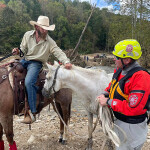Beyond long show days and high humidity, summer also brings intense storms.
Severe weather can strike unexpectedly, often catching people off guard, and no horse owner wants to contemplate the possibility of disasters. Natural disasters provide little, if any, time for decisive action, making an Emergency Action Plan (EAP) crucial for the safety of both horses and humans.
Emergency Action Plan (EAP)
Across the nation, the most common types of severe summer weather include:
- Thunderstorms
- Hurricanes
- Tornadoes
- Floods
For these natural disasters, an EAP serves as a comprehensive guide for horse owners, detailing emergency procedures. Before drafting an EAP, owners should compile essential information about their boarding facility (address, phone number, email, names of the owner, manager, and head trainer), emergency contacts (barn owner, manager, head trainer), and evacuation routes that can accommodate trucks and trailers.
A well-crafted EAP outlines the protocols for handling horses during emergencies and the logistics of relocating them if necessary. It should also include each horse’s packing list, individual responsibilities for all barn personnel, and key contacts (including local law enforcement). The EAP must be reviewed, practiced, and updated annually. Do not wait until the last minute to establish an EAP for your barn.
Before the Storm:
Ensure all horses are up-to-date on vaccinations (especially Rabies and Tetanus) and health care (particularly Coggins). Keep multiple waterproof copies of these records in a sheet protector and store them in a binder. Attach emergency ID tags to your horses, designed specifically for natural disasters. Also, include registration papers and feeding and management information for caretakers. Permanent identification is crucial, such as tattoos, brands for breed registration, or microchips, which are injected subcutaneously and link to online contact information and medical records.
Familiarize yourself with evacuation routes that can accommodate trucks and trailers, and identify temporary facilities that can house your horses. Plan these logistics as early as possible. Assemble comprehensive first aid kits for both humans and horses. Ensure your trucks are in good condition, fueled, and have extra fuel on hand. Trailers should be well-maintained, and your horses should be comfortable being loaded onto a trailer. If not, consult your veterinarian about sedative options.
Prepare an equine disaster kit in waterproof containers. This should include a two-week supply of medications, a five-day supply of hay, feed, and water (though a two-week supply is ideal), extra halters and lead ropes, blankets, towels, wraps, hoof care supplies, medical records, water buckets, bandage scissors, bleach, and other disinfectants, as well as large plastic trash cans.
Prepare your property by ensuring you have functional generators, extra fuel, chainsaws, hammers, nails, saws, and fencing materials. Check fences and gates for needed repairs well before storm season begins. Additionally, have a portable radio, extra batteries, flashlight, headlamp, and multiple portable chargers for cell phones. Include tarps, knives, wire cutters, and shovels.
Practice your disaster plan and coordinate with neighbors who also have horses to assist each other. Develop a community plan that supports everyone. Be aware of animal response teams in case horses are left behind, and contact vet offices, humane societies, equine facilities, and evacuation shelters for additional support.
During the Storm
To ensure the safety of horses during severe weather it may be ideal to keep horses in the barn to protect against lightning, hail, and debris from high winds, but consider turnout during floods to allow them to reach high ground. Depending on the size of turn out pastures it may be ideal to keep horses outside during tornados as well. Horses can navigate to the safest places in large pastures, and this may prevent horses from being trapped from failing structures if a tornado directly hits the stables.
Stay informed using a portable radio for Emergency Broadcasting System alerts and avoid relying solely on Wi-Fi due to potential power outages. Prepare clean, drinking water for both humans and horses in watertight, sealed containers, as automatic water systems may fail if power is lost. If evacuation is necessary, take health records, emergency items, a first aid kit, and sufficient feed and water. Always have a backup plan in place, as unforeseen circumstances can arise despite thorough preparation.
After a Storm
Check pastures and fences for damage and debris. If your horses were left on pasture during the disaster, ensure all horses are accounted for and house them in a secure area. Perform any necessary first aid on injuries and illnesses, and contact a veterinarian if absolutely necessary, keeping in mind that vet arrival times may be delayed. If unknown horses are found on your property, approach with caution, isolate the horse, and contact the authorities and owner if the horse has an ID tag. Provide fresh, clean water and restrict access to flooded pastures or those with downed fences and debris. If it is safe and you have enough human power, start cleaning up your horse property as soon as possible to restore normal function. Ensure compliance with county and state regulations for storm debris disposal.
Severe Storm Preparedness Summary
Significant deliberation and resources are invested in an Emergency Action Plan (EAP) to ensure the safety of both horses and humans. It is crucial to develop a comprehensive plan for all types of severe storms and ensure that everyone involved with your facility is informed of the procedures. Being overly prepared for severe weather is far better than being underprepared, as horse owners bear full responsibility for their horses’ safety during emergencies. Do not rely entirely on U.S. federal emergency agencies to rescue your horses during a disaster.
For more information on severe weather preparedness, please visit The Humane Society of the United States website and resource page: https://www.humanesociety.org/resources/equine-disaster-preparedness.
If you have further questions about severe weather preparedness, do not hesitate to contact your county’s Extension office or your local humane society. The UT-TSU Shelby County Extension office can be reached at 901-752-1207 during regular business hours, Monday through Friday, 8 am-4:30 pm CST.









